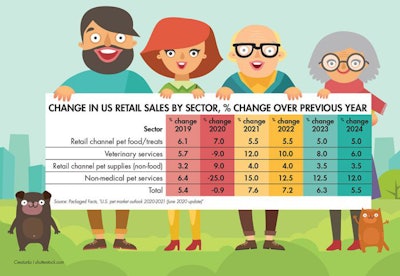
The pet food industry has always been touted as recession resistant, if not recession proof, and that label has certainly been tested so far in 2020. With global economies shaken by the ongoing COVID-19 pandemic, supply chain and transportation challenges seen in many industries, and unemployment numbers in the developed world skyrocketing, it is all the more encouraging that the pet segment is not only slated to hold fast, but to continue growing.
Pet food: a global look
Coming in to 2020, the global pet food market reached more than US$91 billion, growing 6.5% year-over-year in 2019. That growth included double-digit gains for the developing markets in the Asia-Pacific, Eastern Europe and Latin America, and even Western Europe recorded its strongest growth since 2015, said Jared Koerten, industry manager, food and nutrition, for Euromonitor in the May 2020 issue of Pets International Magazine. The trends behind these numbers include the continued global expansion of pet humanization as well as the resulting desire for more premium pet food options.
And then the first half of 2020 happened, and all the previously positive projections for the global pet food market went into flux. Uncertain economies, high unemployment rates and an overall consumer desire to rein in spending have complicated the picture, and it’s difficult to say exactly how the remainder of the year will shake out — but cautious optimism seems to be ruling the day.
“[Global Alliance of Pet Food Associations (GAPFA)] members are seeing increased demand for pet food and pet care products around the globe during the COVID-19 pandemic, similar to demand for human food,” said GAPFA President and Nestlé Purina PetCare Global Director of Regulatory Affairs Dave Corley in a May 2020 interview with FeedInfo News Service. “There are a couple of factors driving this, including pet owners wanting to be sure they have plenty of food on hand to care for their pets, and a surge in dog and cat adoptions and fostering while millions are staying at home around the world.”
Pet food was deemed an “essential service” all over the world as governments determined what businesses to prioritize at the beginning of the pandemic, making pet food-related entities from manufacturing facilities to retail outlets exempt from mandatory closures.
ResearchAndMarkets.com is currently estimating a compound annual growth rate (CAGR) of 1.3% for the global pet food market — low, for sure, but still growth. And it’s almost inevitable that the industry will rebound in future years to make up for it, though just what that rebound might look like is hard to say.
“After a stellar 2019, pet care stands at a crossroads,” said Euromonitor. “… the COVID-19 pandemic ushered in a period of significant uncertainty, with social isolation, shifts in shopper behavior, strained supply chains and an unprecedented recession on the horizon.”
Pet food: U.S. market highlights
According to the American Pet Products Association (APPA), in 2019 US$95.7 billion was spent on pets in the U.S., US$36.9 billion of that in pet food and treats. When adjusted for current global events, those numbers are still estimated to go up in 2020, to US$99.0 billion total and US$38.4 billion in pet food and treats.
“One unexpected result of COVID-19 has been the rise of new pet owners, as many Americans opted to either foster or adopt,” said Sean Simpson, associate client director for Nielsen’s pet practice, in an article written for Pet Business in May 2020. “There have been numerous stories of fostering facilities and shelters going empty, and Nielsen data shows a correlated uptick in retail sales. Sales of pet bedding and accessories spiked, but not during the pantry loading period in late March 2020. Those sales increased in late April 2020, indicating that new pet parents were buying essential hard goods. Pets finding their forever homes is the feel-good story we need right now, as the increase in adoption and fostering is both good for the pets and the industry as a whole. A growing population of pet-owning households means a growing need for pet food and products in the U.S.”
According to Packaged Facts’ latest report, “U.S. Pet Market Outlook 2020–2021 (June 2020 update),” pet food is the most essential segment of the pet products industry, and so is in the best position to weather the challenges of COVID-19 and beyond. In addition, U.S. consumers place a high level of importance on pet ownership and companionship, which alongside the boost in pet adoptions will bolster pet food and treat sales through 2021.
Undoubtedly, the pet food arena can be highlighted as one of the primary reasons U.S. retail sales of pet products and services are only set to decrease 0.9% from 2019 numbers (the original forecast, according to Packaged Facts data, was a growth of 5.3%). As other retail segments such as grooming and boarding services take significant hits, pet food continues to provide growth to the industry (see Table 1).
ABLE 1: Non-medical pet services are expected to take by far the most significant hit in 2020, with retail channel pet food, treats and non-food supplies stepping in as the only growth segments. | Creatarka I Shutterstock.com
Pet food rebound: what happens after COVID-19
The good news, if there can be said to be any, is that the pet industry overall is projected to rebound pretty handily from 2020.
E-commerce, already a growing trend, has been pulled into the limelight and may very well become the top channel for pet product sales by 2024, according to Packaged Facts’ report, “U.S. Pet Market Outlook, 2020–2021: The COVID-19 Impact.” In 2020, e-commerce sales of pet products are expected to make up 27% of all sales.
Pre-pandemic projections of pet products/services retail sales were obviously more stable than they are now; according to Packaged Facts data, U.S. sales have been revised down compared to numbers at the beginning of 2020 for the next few years — the industry overall will still be recovering in 2023, previously estimated to bring in US$116.06 billion and as of June 2020 revised down to US$115.44 billion. But by 2024 rough estimates actually have the retail sector slightly ahead of pre-pandemic estimates, at US$121.81 billion rather than the originally projected US$121.65 billion.
The road may not be smooth, but the pet food industry won’t be going anywhere but up any time soon.


















